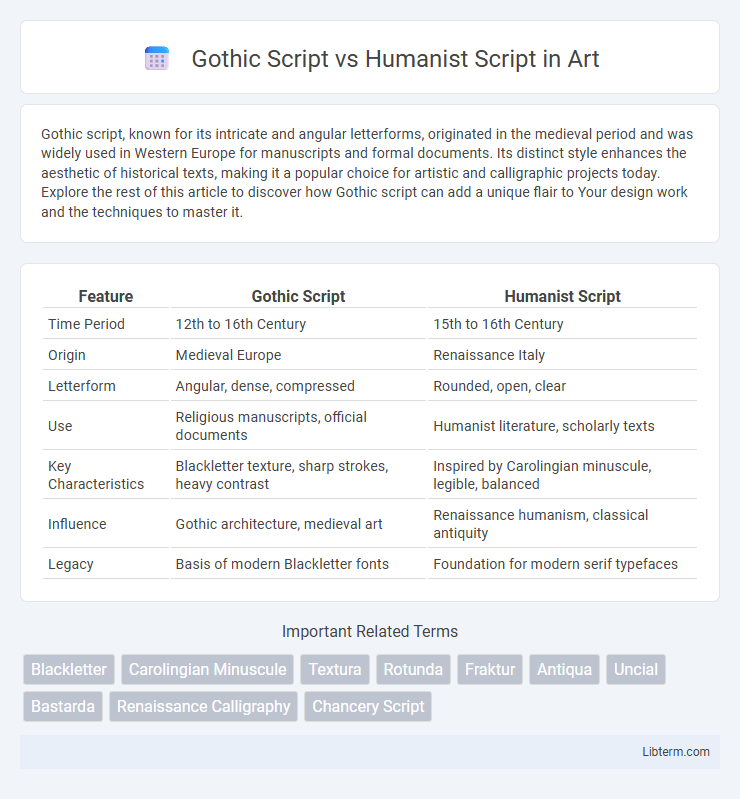Gothic script, known for its intricate and angular letterforms, originated in the medieval period and was widely used in Western Europe for manuscripts and formal documents. Its distinct style enhances the aesthetic of historical texts, making it a popular choice for artistic and calligraphic projects today. Explore the rest of this article to discover how Gothic script can add a unique flair to Your design work and the techniques to master it.
Table of Comparison
| Feature | Gothic Script | Humanist Script |
|---|---|---|
| Time Period | 12th to 16th Century | 15th to 16th Century |
| Origin | Medieval Europe | Renaissance Italy |
| Letterform | Angular, dense, compressed | Rounded, open, clear |
| Use | Religious manuscripts, official documents | Humanist literature, scholarly texts |
| Key Characteristics | Blackletter texture, sharp strokes, heavy contrast | Inspired by Carolingian minuscule, legible, balanced |
| Influence | Gothic architecture, medieval art | Renaissance humanism, classical antiquity |
| Legacy | Basis of modern Blackletter fonts | Foundation for modern serif typefaces |
Introduction to Gothic and Humanist Scripts
Gothic script, originating in the 12th century, is characterized by its dense, angular, and ornate letterforms designed for medieval manuscripts and formal documents. Humanist script emerged in the 15th century during the Renaissance, inspired by classical Roman letterforms, emphasizing clarity, legibility, and proportion. These distinct scripts reflect cultural shifts, with Gothic embodying medieval aesthetics and Humanist script marking the revival of ancient typographic principles.
Historical Origins of Gothic Script
Gothic Script, emerging in the 12th century during the High Middle Ages, developed as a dense and angular writing style to conserve parchment and increase the speed of manuscript production across Europe. Originating from Carolingian minuscule, Gothic Script evolved in monastic scriptoria and urban centers, becoming the dominant script in legal, religious, and literary texts throughout the 13th to 15th centuries. In contrast, Humanist Script arose in 15th-century Italy, inspired by classical Roman letterforms and Renaissance humanism, representing a deliberate return to clarity and simplicity in handwriting.
Emergence of Humanist Script
The emergence of Humanist Script in the 15th century marked a significant departure from the dense and angular forms of Gothic Script, embracing clarity and legibility inspired by classical Roman inscriptions. Humanist scribes sought to revive the human-centered values of the Renaissance, developing a script characterized by open, rounded letterforms that facilitated faster reading and writing. This shift not only influenced the aesthetics of manuscripts but also laid the foundation for the modern Roman typefaces used in contemporary printing.
Key Visual Differences
Gothic Script features dense, angular, and tightly packed letterforms with pointed arches and sharp strokes, creating a dark, textured appearance. Humanist Script displays more open, rounded shapes with clear vertical axis and greater spacing, reflecting classical Roman cursive and promoting legibility. The contrast between Gothic's intricate complexity and Humanist's simplified elegance marks their key visual distinction.
Cultural and Regional Influences
Gothic Script, prevalent in medieval Northern Europe, reflects the region's emphasis on religious tradition and rigidity through its dense, angular forms, while Humanist Script emerged in Renaissance Italy, embodying classical revival and human-centric values with its clear, rounded letters inspired by ancient Roman inscriptions. The cultural shift from the somber spirituality of the Middle Ages to the humanistic optimism of the Renaissance drove these scripts' stylistic divergence, highlighting regional intellectual movements and societal priorities. Regional patronage and educational centers like monasteries in Northern Europe and Italian academies shaped the propagation and refinement of these distinct writing styles.
Script Usage in Manuscripts and Print
Gothic Script dominated manuscript production in Northern Europe from the 12th to the 15th century, characterized by dense, angular letterforms optimized for compact text blocks in religious and scholarly works. Humanist Script emerged during the Renaissance, reflecting classical Roman calligraphy with more open, rounded letters, preferred in Italian manuscripts and early printed books for its clarity and readability. In print, Humanist Script influenced the development of Roman typefaces, while Gothic Script remained prevalent in German print well into the 16th century, illustrating regional preferences in typographic tradition.
Readability and Aesthetic Appeal
Gothic Script features dense, angular letterforms with tightly packed strokes that create a dramatic aesthetic but often reduce readability due to its complexity and ornate design. Humanist Script, inspired by classical Roman inscriptions, emphasizes open, rounded shapes and clear spacing, enhancing legibility and providing a more approachable, elegant visual appeal. The choice between these scripts balances Gothic's intricate, historical texture against Humanist's clean, readable form, influencing typography in medieval manuscripts and Renaissance humanistic texts respectively.
Impact on Modern Typography
Gothic Script, characterized by its dense and angular letterforms, influenced modern typography by inspiring bold, dramatic typefaces often used in branding and headlines to evoke tradition and authority. Humanist Script, with its more open, calligraphic style rooted in Renaissance humanism, laid the foundation for contemporary serif fonts emphasizing readability and elegance. These contrasting scripts collectively shaped the evolution of modern type design, balancing ornamental complexity with functional clarity.
Contemporary Applications
Gothic script, characterized by its dense and angular letter forms, is commonly utilized in modern branding and tattoo designs to evoke a sense of medieval authenticity and dramatic flair. Humanist script, with its more open and flowing lines inspired by Renaissance calligraphy, finds contemporary application in digital typography and luxury packaging to communicate elegance and readability. Both scripts influence present-day graphic design, balancing historical significance with aesthetic appeal for niche markets.
Conclusion: Legacy of Gothic vs Humanist Scripts
The legacy of Gothic Script is marked by its intricate and angular design, influencing medieval manuscripts, calligraphy, and modern typography with a distinct sense of formality and decoration. Humanist Script, characterized by its more rounded and open letterforms inspired by classical Roman inscriptions, laid the foundation for contemporary typefaces like serif fonts, promoting readability and elegance. Both scripts shaped Western written culture, with Gothic embodying medieval tradition and Humanist paving the way for Renaissance humanism and modern typography.
Gothic Script Infographic

 libterm.com
libterm.com